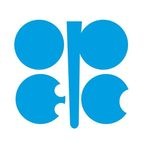The Ripple Effect: Oil Prices and the Dollar's Struggle Amid Fiscal Woes
May 23, 2025, 11:18 pm
In the world of finance, every action sends ripples through the market. Recently, oil prices have taken a hit, settling lower as whispers of increased OPEC+ production loom. Meanwhile, the dollar finds itself under pressure, grappling with rising fiscal anxiety. These two narratives intertwine, painting a picture of a global economy at a crossroads.
Oil prices have been on a downward trajectory. Brent crude futures dipped to $64.44 a barrel, while U.S. West Texas Intermediate (WTI) crude fell to $61.20. This decline marks a significant moment for investors, who are weighing the implications of potential supply increases from OPEC+. The organization is reportedly considering ramping up production in July, a move that could tip the scales of supply and demand.
Investors are cautious. The market is like a tightrope walker, balancing precariously between supply concerns and demand growth. With OPEC+ discussing output increases, fears of oversupply are creeping in. The market is not convinced. It’s a classic case of uncertainty, where speculation reigns supreme.
The dollar's plight adds another layer to this complex tapestry. It is under pressure, facing its first weekly decline in five weeks against major currencies. Long-dated Treasury yields remain elevated, a sign of the growing anxiety surrounding U.S. fiscal health. The recent downgrade of the U.S. credit rating by Moody's has sent shockwaves through the financial landscape. Investors are now more focused on fiscal concerns than on trade tariffs, a shift that underscores the gravity of the situation.
The Republican-controlled House of Representatives has passed a sweeping tax and spending bill, but the implications of this move are still unfolding. The dollar's struggle is palpable, as it grapples with the weight of these fiscal anxieties. It’s like a ship caught in a storm, tossed about by waves of uncertainty.
As the dollar falters, other currencies gain ground. The euro has seen a rise, but this comes with its own set of challenges. A stronger euro can hurt exporters, making their goods more expensive abroad. Yet, European markets have shown resilience. The Stoxx 600 share index gained 0.3%, and Germany's Xetra Dax added 0.4%. Investors are navigating these waters with caution, weighing the risks and rewards.
In Asia, the Nikkei index rose by 0.5%, reflecting a broader trend of cautious optimism. The MSCI index of Asia-Pacific shares outside Japan also saw a similar uptick. However, the underlying tension remains. The global economy is like a game of chess, with each move carefully calculated, yet fraught with uncertainty.
Bitcoin, too, has been part of this narrative. After reaching record highs, it dipped but still managed a weekly gain of 6.4%, settling at $110,796. This volatility mirrors the broader market sentiment—dynamic, unpredictable, and often influenced by external factors.
Amidst these fluctuations, oil prices have faced their own challenges. They dropped for the fourth consecutive session, marking the first weekly decline in three weeks. The potential OPEC+ output hike looms large, casting a shadow over the market. Brent futures fell to $63.89, while WTI crude dipped to $60.65. The market is reacting to the possibility of increased supply, a classic case of supply outpacing demand.
In the realm of precious metals, gold has emerged as a safe haven. Prices rose over 1% to $3,321 an ounce, as investors seek refuge from the storm. Gold often shines brightest in times of uncertainty, acting as a buffer against market volatility.
The interconnectedness of these financial narratives is striking. Oil prices, the dollar's struggles, and fiscal anxieties are all threads in the same fabric. Each element influences the others, creating a complex web of cause and effect. Investors are left to navigate this intricate landscape, making decisions that could have far-reaching consequences.
As we look ahead, the market remains in flux. OPEC+'s decisions will play a crucial role in shaping oil prices. The dollar's fate hangs in the balance, influenced by fiscal policies and global economic conditions. Investors must remain vigilant, ready to adapt to the ever-changing tides of the market.
In conclusion, the current financial landscape is a reflection of broader economic realities. Oil prices are under pressure from potential supply increases, while the dollar grapples with fiscal anxieties. These narratives are intertwined, creating a complex picture of a global economy at a crossroads. Investors must tread carefully, for the ripples of today will shape the currents of tomorrow.
Oil prices have been on a downward trajectory. Brent crude futures dipped to $64.44 a barrel, while U.S. West Texas Intermediate (WTI) crude fell to $61.20. This decline marks a significant moment for investors, who are weighing the implications of potential supply increases from OPEC+. The organization is reportedly considering ramping up production in July, a move that could tip the scales of supply and demand.
Investors are cautious. The market is like a tightrope walker, balancing precariously between supply concerns and demand growth. With OPEC+ discussing output increases, fears of oversupply are creeping in. The market is not convinced. It’s a classic case of uncertainty, where speculation reigns supreme.
The dollar's plight adds another layer to this complex tapestry. It is under pressure, facing its first weekly decline in five weeks against major currencies. Long-dated Treasury yields remain elevated, a sign of the growing anxiety surrounding U.S. fiscal health. The recent downgrade of the U.S. credit rating by Moody's has sent shockwaves through the financial landscape. Investors are now more focused on fiscal concerns than on trade tariffs, a shift that underscores the gravity of the situation.
The Republican-controlled House of Representatives has passed a sweeping tax and spending bill, but the implications of this move are still unfolding. The dollar's struggle is palpable, as it grapples with the weight of these fiscal anxieties. It’s like a ship caught in a storm, tossed about by waves of uncertainty.
As the dollar falters, other currencies gain ground. The euro has seen a rise, but this comes with its own set of challenges. A stronger euro can hurt exporters, making their goods more expensive abroad. Yet, European markets have shown resilience. The Stoxx 600 share index gained 0.3%, and Germany's Xetra Dax added 0.4%. Investors are navigating these waters with caution, weighing the risks and rewards.
In Asia, the Nikkei index rose by 0.5%, reflecting a broader trend of cautious optimism. The MSCI index of Asia-Pacific shares outside Japan also saw a similar uptick. However, the underlying tension remains. The global economy is like a game of chess, with each move carefully calculated, yet fraught with uncertainty.
Bitcoin, too, has been part of this narrative. After reaching record highs, it dipped but still managed a weekly gain of 6.4%, settling at $110,796. This volatility mirrors the broader market sentiment—dynamic, unpredictable, and often influenced by external factors.
Amidst these fluctuations, oil prices have faced their own challenges. They dropped for the fourth consecutive session, marking the first weekly decline in three weeks. The potential OPEC+ output hike looms large, casting a shadow over the market. Brent futures fell to $63.89, while WTI crude dipped to $60.65. The market is reacting to the possibility of increased supply, a classic case of supply outpacing demand.
In the realm of precious metals, gold has emerged as a safe haven. Prices rose over 1% to $3,321 an ounce, as investors seek refuge from the storm. Gold often shines brightest in times of uncertainty, acting as a buffer against market volatility.
The interconnectedness of these financial narratives is striking. Oil prices, the dollar's struggles, and fiscal anxieties are all threads in the same fabric. Each element influences the others, creating a complex web of cause and effect. Investors are left to navigate this intricate landscape, making decisions that could have far-reaching consequences.
As we look ahead, the market remains in flux. OPEC+'s decisions will play a crucial role in shaping oil prices. The dollar's fate hangs in the balance, influenced by fiscal policies and global economic conditions. Investors must remain vigilant, ready to adapt to the ever-changing tides of the market.
In conclusion, the current financial landscape is a reflection of broader economic realities. Oil prices are under pressure from potential supply increases, while the dollar grapples with fiscal anxieties. These narratives are intertwined, creating a complex picture of a global economy at a crossroads. Investors must tread carefully, for the ripples of today will shape the currents of tomorrow.

